The Voigtlander Vito II is a simple 35mm folding camera with a 50mm f/3.5 lens. Mine has seen better days, but it still works and in its own way is a pleasure to use. It’s also a close relative of a camera that’s quite important in the history of my photographic journey, and makes up a part of a small but, I would argue, well-formed Voigtlander collection. I actually don’t shoot with any of them that much, in fact it’s been ages since I’ve really thought much about them at all. As such, I thought it about time I at least put a roll through one of them and shared my thoughts on the experience.
Voigtlander and my brand loyalty
In my early 20’s I got a job as a retail assistant in a camera shop – I’d been interested in photography for a long time, but this job was to have a big influence on my photography; both as a hobby, and eventually as a career. With it being a shop that sold lots of new fangled digital gear alongside a lot of used film equipment I had a steep learning curve. I embraced the learning by spending as much time as possible researching cameras and lenses online, as well as talking to the other members of staff and customers who came into the shop. There were a few customers that I become quite pally with too – a couple of which who would pop in most Saturdays to chat about the latest gear they were never likely to buy, or their latest charity shop or boot sale acquisition. Anyone who has worked in camera retail, or similar, will know the type – amusingly, I think I might be one of them myself now…
One particular customer, a chap named Len, popped in one Saturday and was quite excited to tell me about a gem of a camera that a mate of his had shown him. This particular camera was a Voigtlander Vito B. He proceeded to tell me that its German build quality was akin to a Leica, but that these cameras were readily available to buy off eBay for less than £20. After he left, I dived onto the computer, and quickly bought one for £16 – I’m not sure why I remember that exact price, but I do.
Not long later, with my new Voigtlander Vito B in one hand and an old light meter in the other, I went for a walk down by the river in Worcester. I started that walk with a basic understanding of aperture and shutter speed in terms of what effect they had on the photographic outcome, but thanks to the simple nature of the camera, I discovered the reciprocal nature found between the core camera settings. For the first time, the exposure triangle made sense to me. I still have that camera, and still treasure it for the part it had in teaching me some of those fundamentals of photography.
This experience formed the basis for an affinity with the Voigtlander brand which soon led to me buying a Voigtlander R2a and a whole load of lenses. This in turn provided me with my first really positive experiences with rangefinder cameras. Of course I now know that the Voigtlander we know today isn’t the German brand it once was, but it’s fair to say that my early respect for the brand (whoever happened to own it) was definitely based upon my experience of the Voigtlander Vito B.
I’ve had many other Voigtlander cameras since then too. A few of the Cosina-made rangefinders have passed through my hands since my R2a. But as well as those – all of which I have now been sold – I have the small collection of vintage Voigtlander cameras that I mentioned at the beginning of this post. One of which is the Voigtlander Vito II
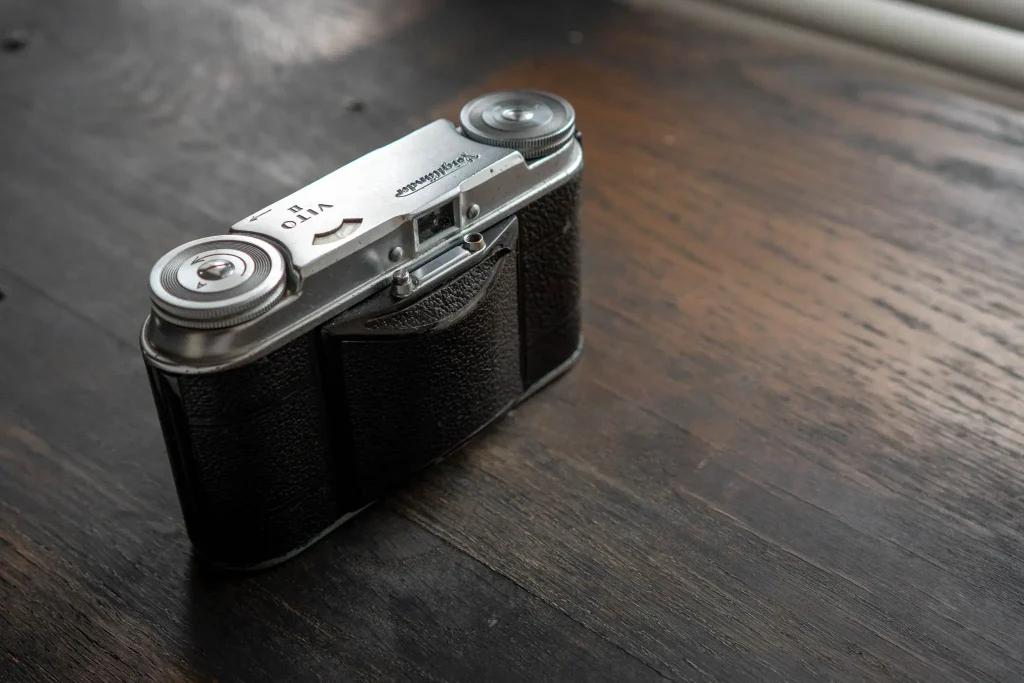
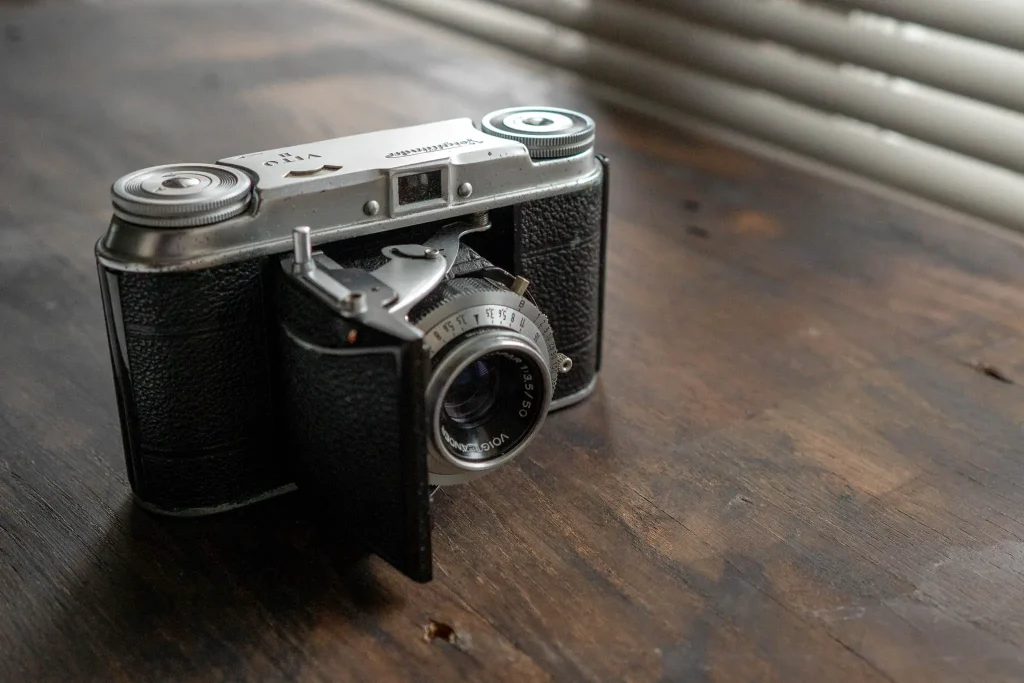
The Voigtlander Vito II
The Voigtlander Vito II predates the Vito B, and as such is a little less convenient to use. As mentioned, it’s a folding camera with an 50mm f/3.5 lens. On my version, the lens is mounted in a compur-rapid shutter with speeds from 1 second to 1/500th and Bulb – all of which seem to work close enough for fairly normal usage. Both shutter speed and aperture are set on the lens. This is true of the later Vito B, but the layout of the controls – at least on the first versions of the Vito B cameras – is much quicker to understand at a glance.
The shutter on the Voigtlander Vito II needs to be re-cocked manually and separately from advancing the film. This is achieved by pressing down on the small lever on the side of the lens. Additionally, the flash-sync socket juts out just above the shutter cocking lever. Both lever and socket sit in between the shutter dial that’s controlled by a ring around the circumference of the shutter, and the aperture lever which sits at the rear, closest to the bellows. All of this makes for quite a cluttered set of controls and dials around the lens.
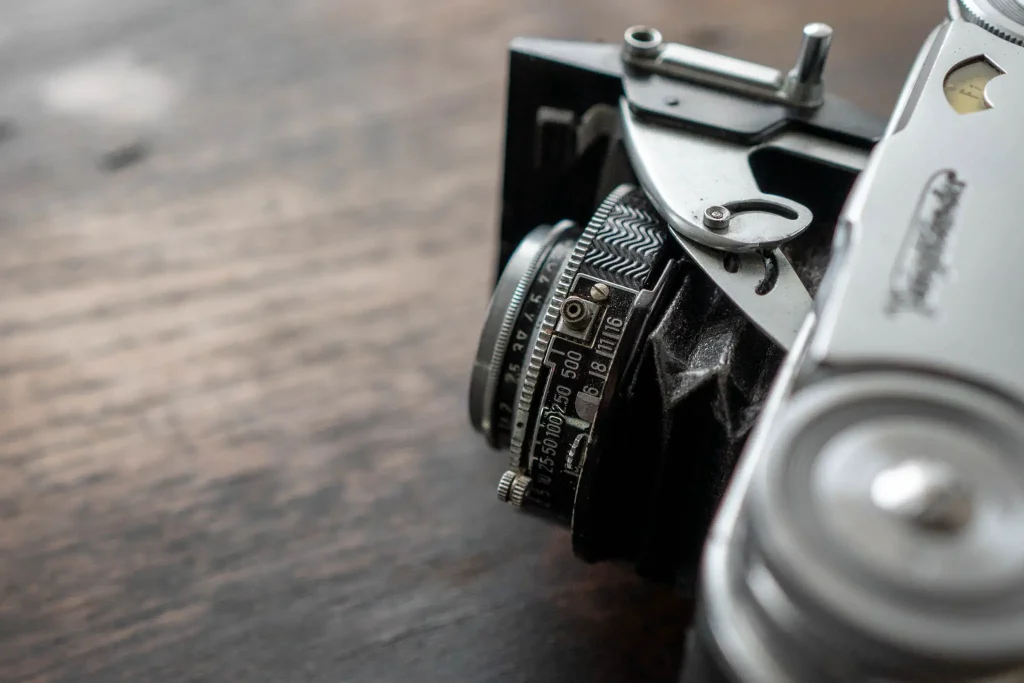
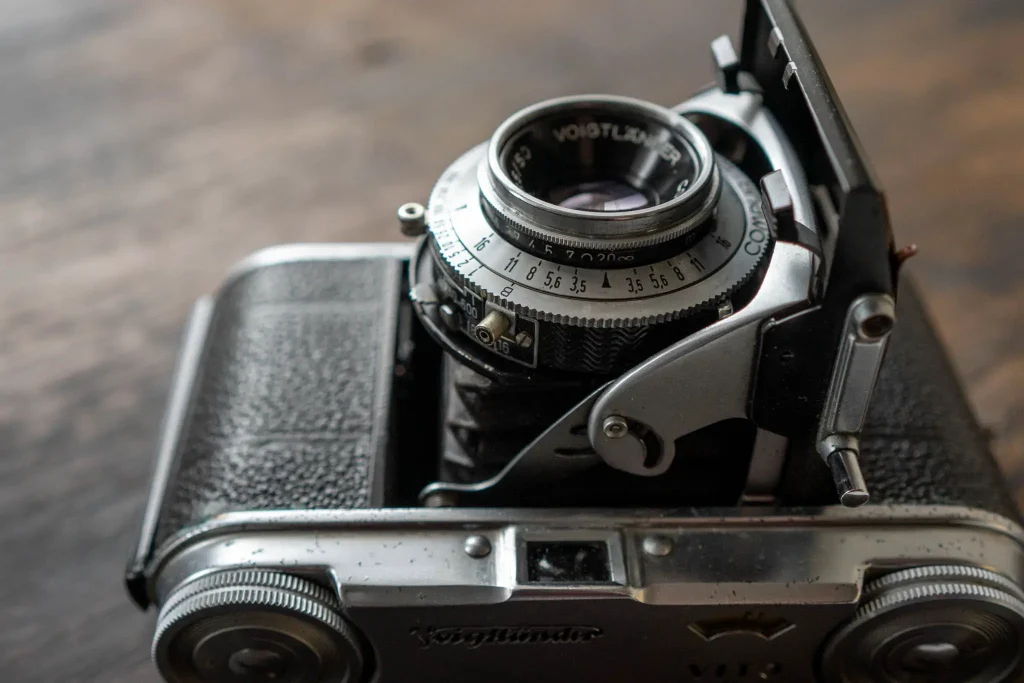
This is nothing to worry about if you’re used to cameras with this nature of shutter. Many cameras of this vintage and older have lenses like this – as do even some if not most of modern large format lenses. As such, in the hands of those who are used to using them, it will all feel like second nature, I’m sure. I’m just glad that I picked up a Vito B way-back-when, as I think this sort of layout of control might have confused me a bit.
Even today, as someone who is familiar with this sort of camera, it still takes me a few seconds to find the dials for setting aperture and shutter speed when I first pick the Voigtlander Vito II up after a while – and I rarely remember to cock the shutter. I should add though, this isn’t me being critical as such – “reviewing” a camera of this age, it makes little sense to admonish it for such issues. As I say, they improved the controls on later models; it’s an old camera, it has its foibles, you get used to them if you have a desire to shoot such a thing. And, it does at least have a proper shutter button – all be it on top of the lens door – which is more than can be said of some of these more elderly cameras.
Shooting the Vito II
As a folder, obviously the lens has to be extended for it to be used. The front of the Voigtlander Vito II is released via the little button set into the base plate. On a well-functioning one, the lens would lock into the open position, with the two black-tipped finger-press release levers allowing it to be returned to the closed position. In the case of my Vito II, the mechanism has worn enough for it to be closed without pressing the release buttons. More convenient to use, perhaps, but it also gives the sense that the lens might not be perfectly located in the shooting position. I had to develop a method of holding my Voigtlander Vito II that ensured the lens was fully extended. This is no big deal, it’s merely another foible that I accepted as part of shooting it.
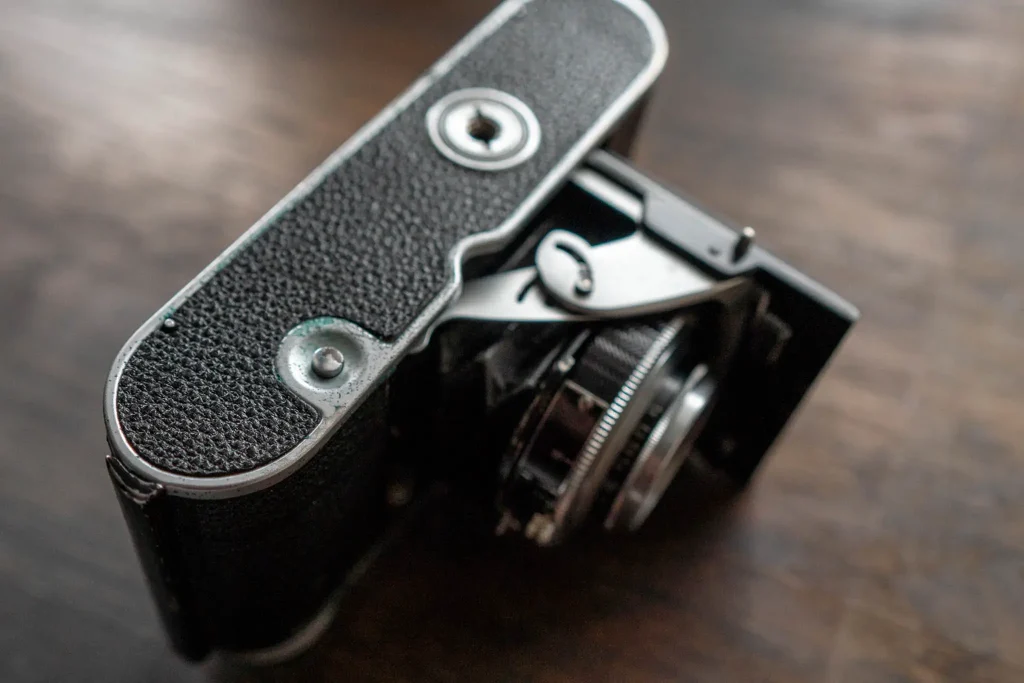
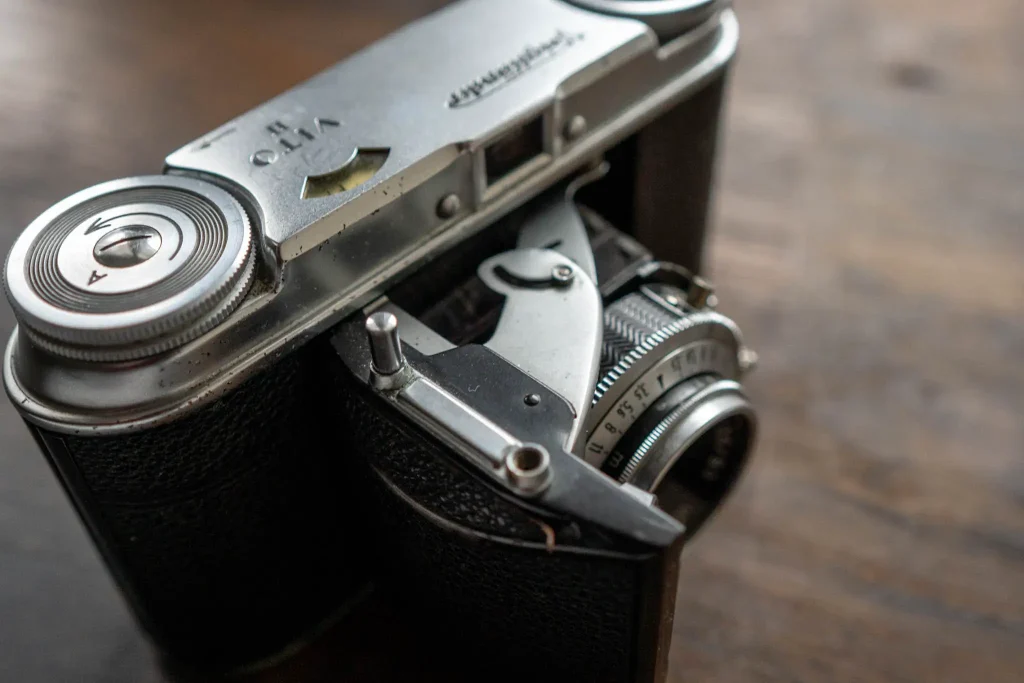
Once I’ve got my brain around the shutter and aperture – both of which are ideally set to appropriate settings for the general shooting conditions, rather than on a shot by shot basis – I find the Voigtlander Vito II quite easy, and indeed quite pleasant to shoot with. The Voigtlander Vito II is very much a zone focus camera. Voigtlander did make accessory rangefinders for cameras like this, but I prefer to shoot without such a thing – not least because my accessory rangefinder scale is in feet, and this lens’s dial has a metric scale. I think it’s part of the joy of a camera like this anyway – as I say, you set the shutter and aperture to what’s appropriate for the general conditions and then just think about focusing. With the latitude of many modern films, simple application of the sunny-16 rule and erring toward overexposure will combat any exposure issues anyway.
Focusing, fortunately, is much easier than setting the shutter and aperture. Turning the focus control could be considered slightly fiddly, I suppose, as it take a thumb and forefinger around the frontmost part of the lens – but it’s not something you do with the Voigtlander Vito II to your eye, so it doesn’t feel too bad. The focus has a nice long throw to it too, which brings the advantage of a nice wide depth of field scale for zone focusing. If you don’t know how to focus a lens like this, check out this post I wrote for Ilford a few years back.
Once the shutter is fired – making the slightest of noises common to leaf shutters like this – the film is advanced using the dial marked ‘A’ for advance on the top of the Voigtlander Vito II. It makes a satisfying click when it’s advanced to the next frame. When the roll is finished, you lift a little lever on the top edge of the back plate, then rotate the dial marked ‘R’ for rewind. Under this lever is also a little dial for setting the shutter counter.
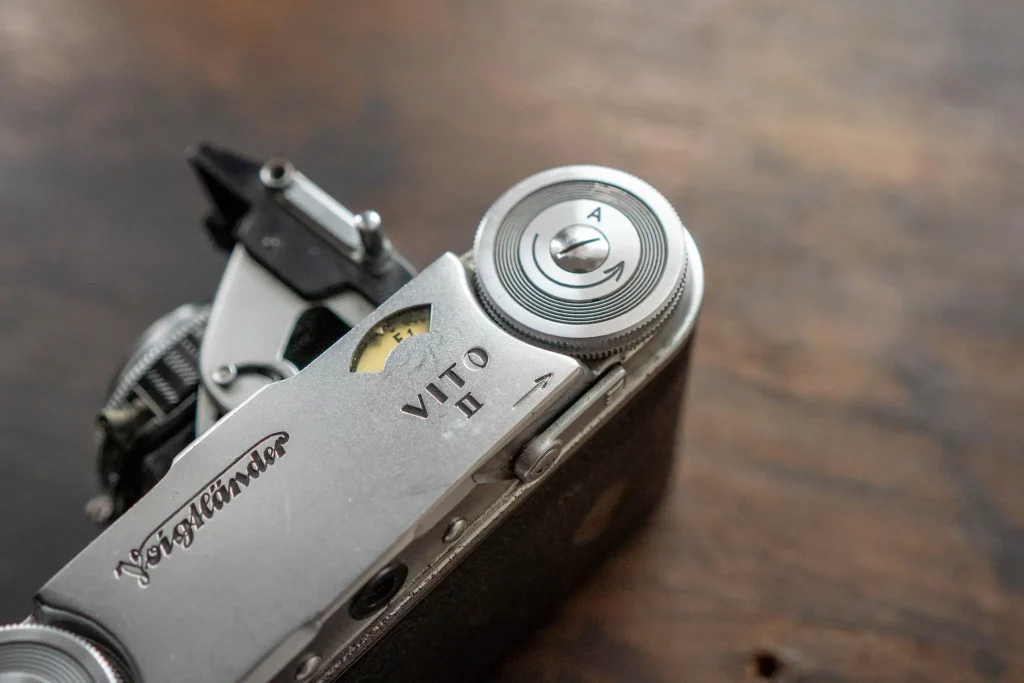
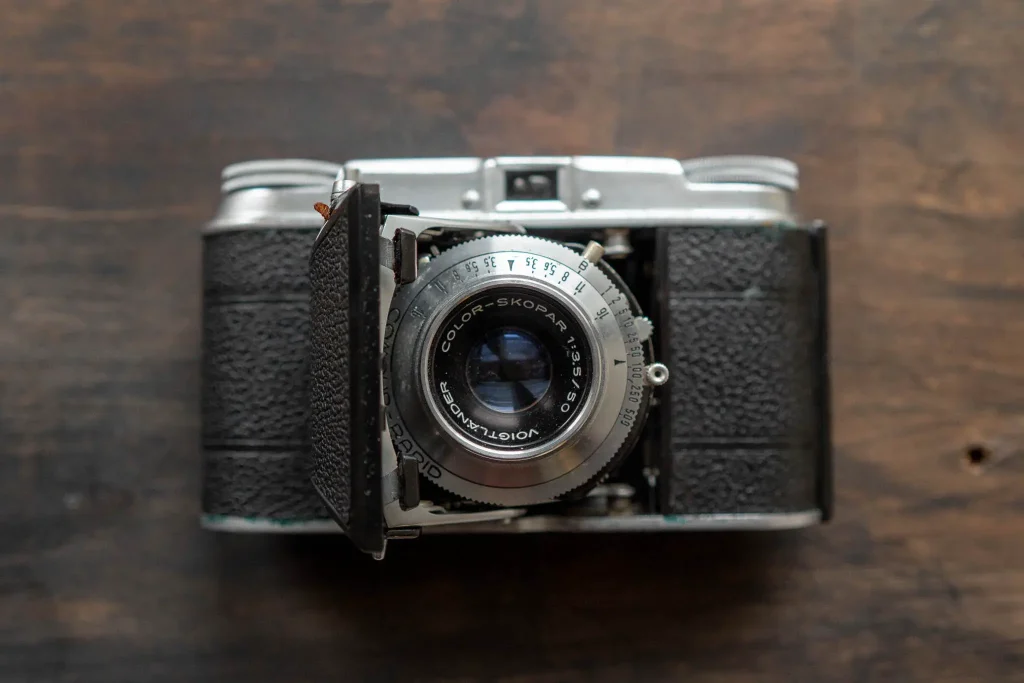
The lens
The little Voigtlander 50mm f/3.5 Color-Skopar is a coated lens based on the Tessar formula. Of course, because of its age, the quality of the results that are achievable are going to be variable from one camera to the next, in theory though it’s a great little lens with a good reputation for quality.
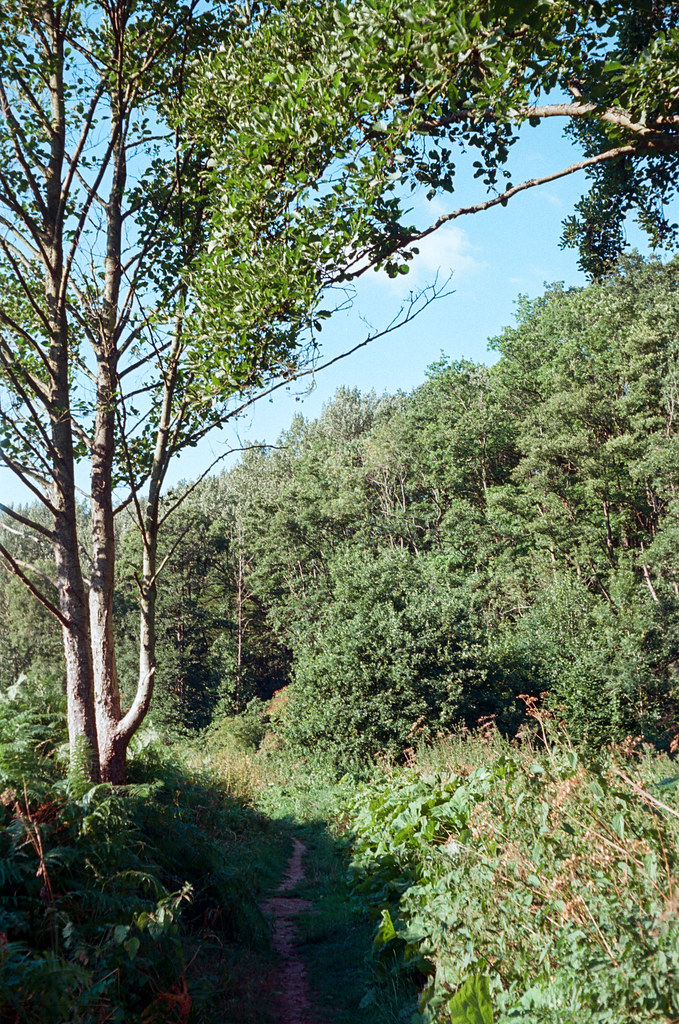
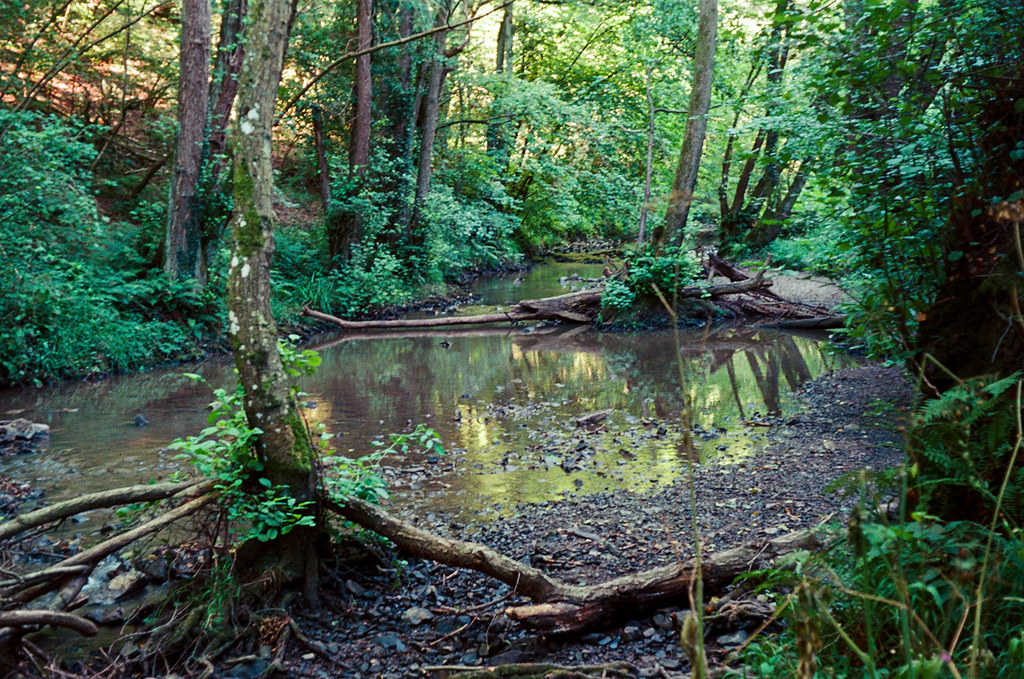
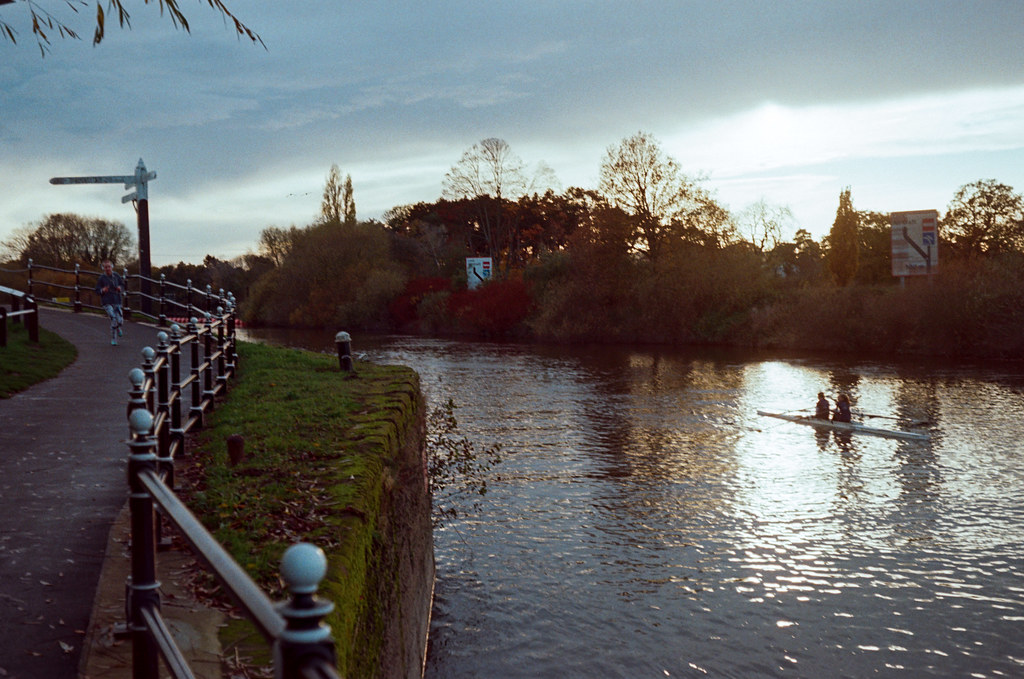
I slightly distorted my ability to judge the quality of the lens through changing two other variables in my normal workflow. I shot a roll of Kodak Ultramax 400, which I haven’t shot for ages, and just as an experiment had it developed at Boots the chemist. The results have come back with a slightly pastel, or at least slightly vintage-photo-looking colour pallet which is quite possibly a product of the lens, or something else in the chain, I can’t really be certain. Either way, it doesn’t matter – if I was looking for perfection, I wouldn’t be taking photos with a lens designed in the late 1940’s.
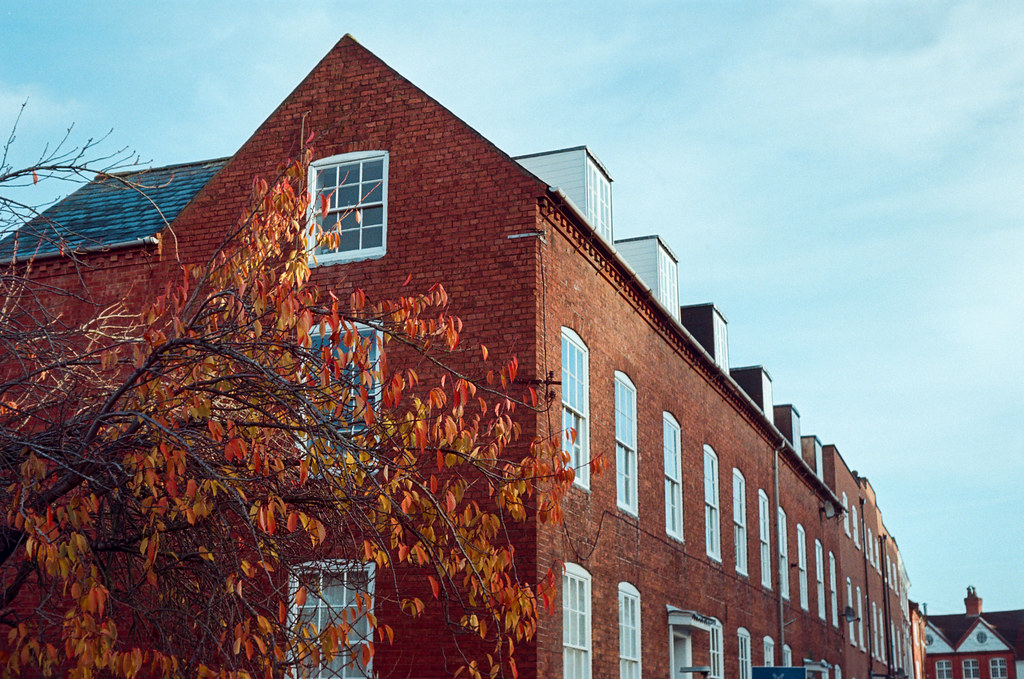
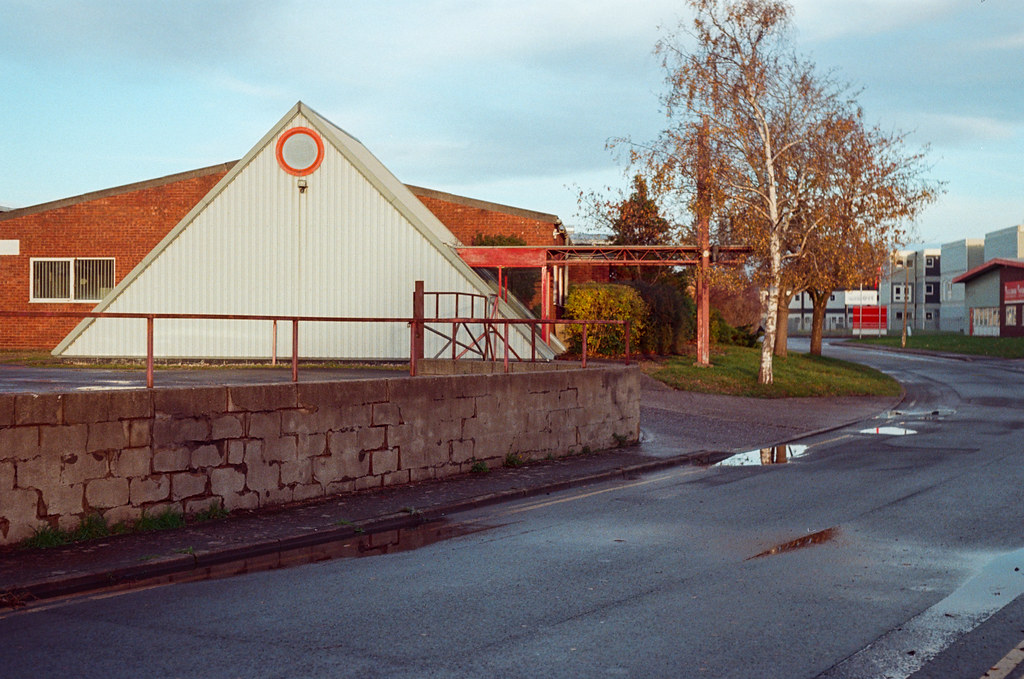
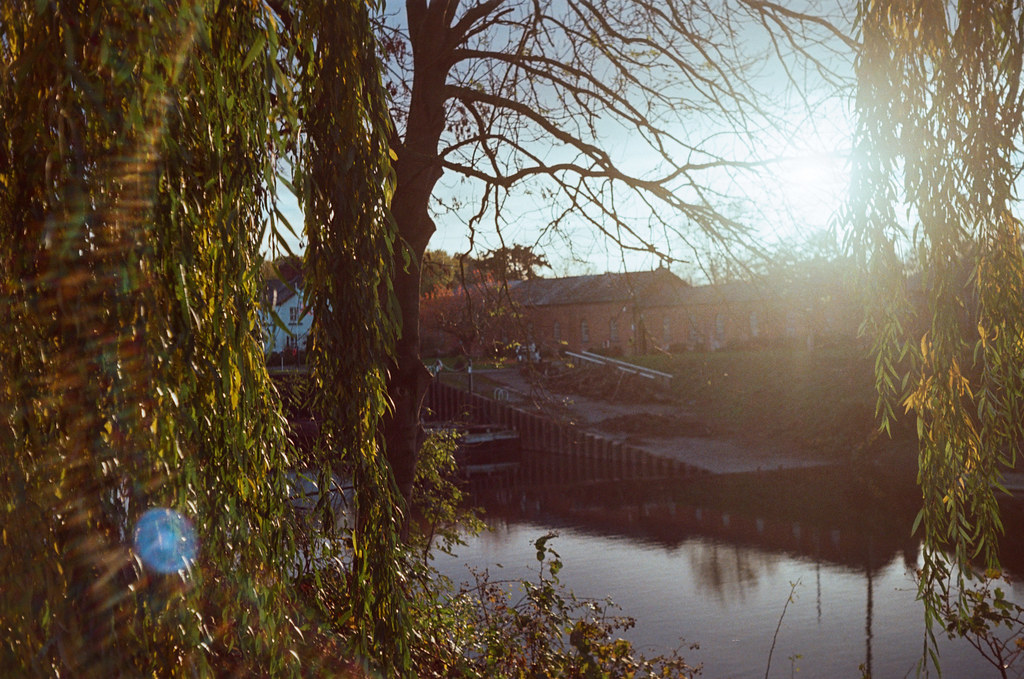
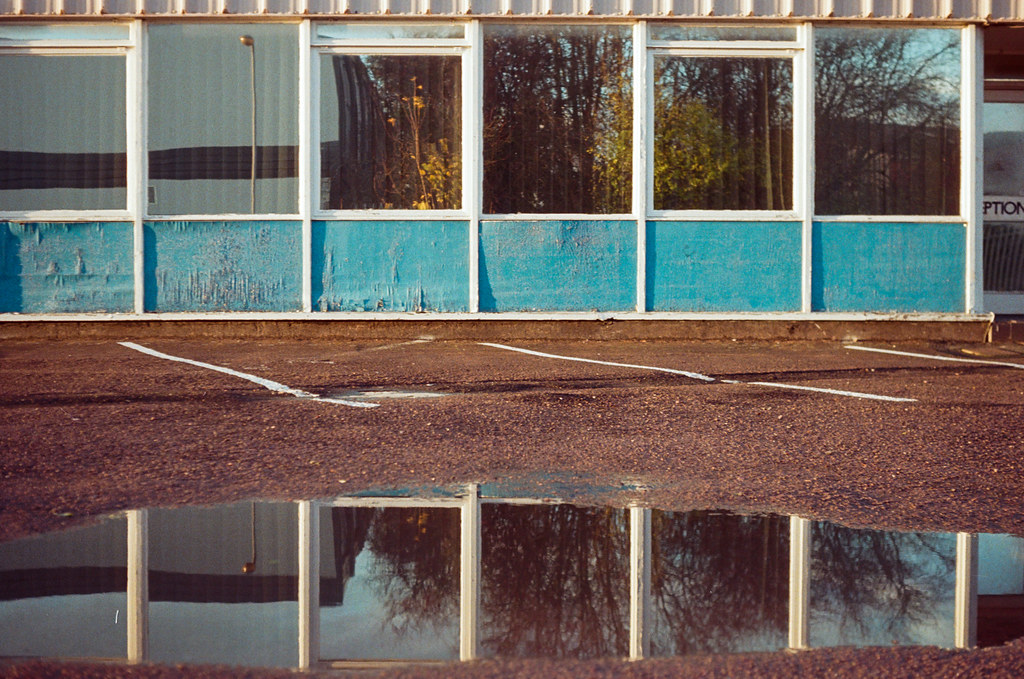
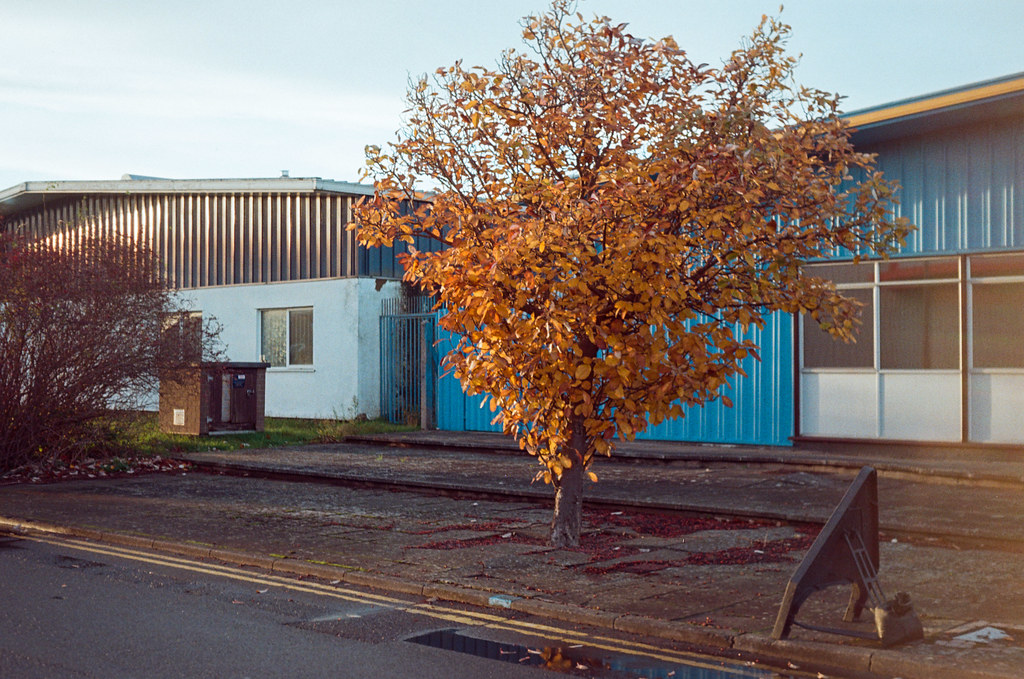
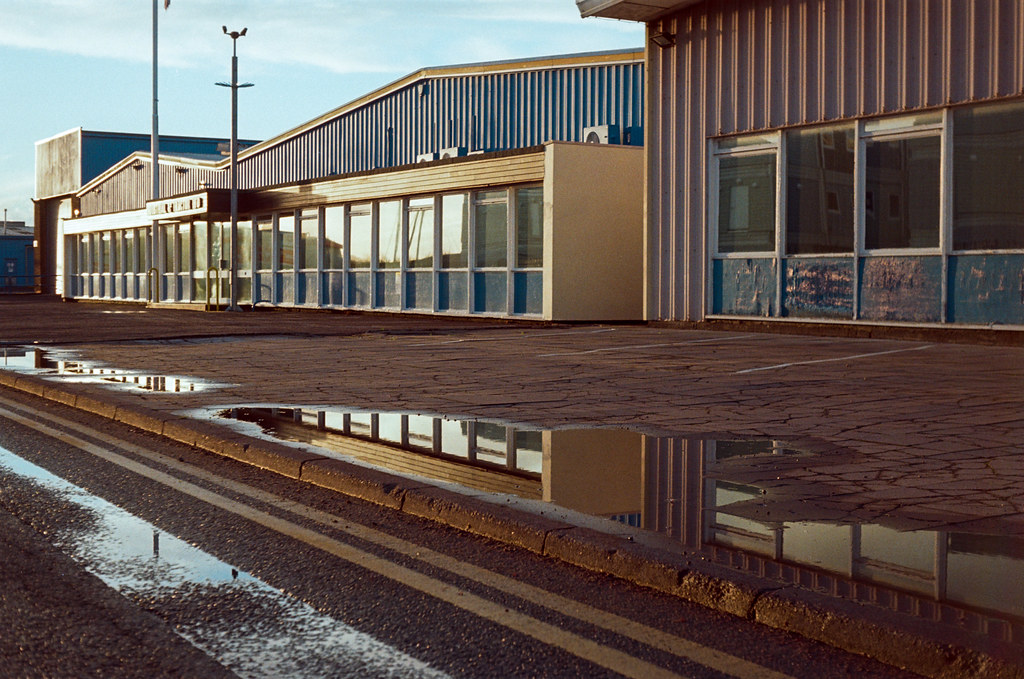
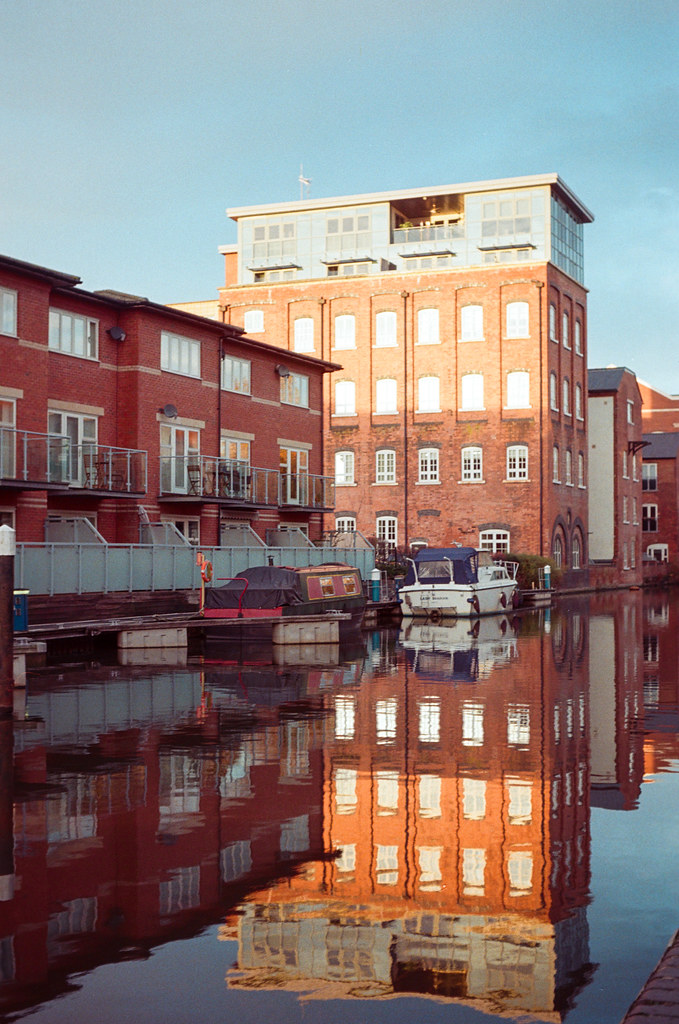
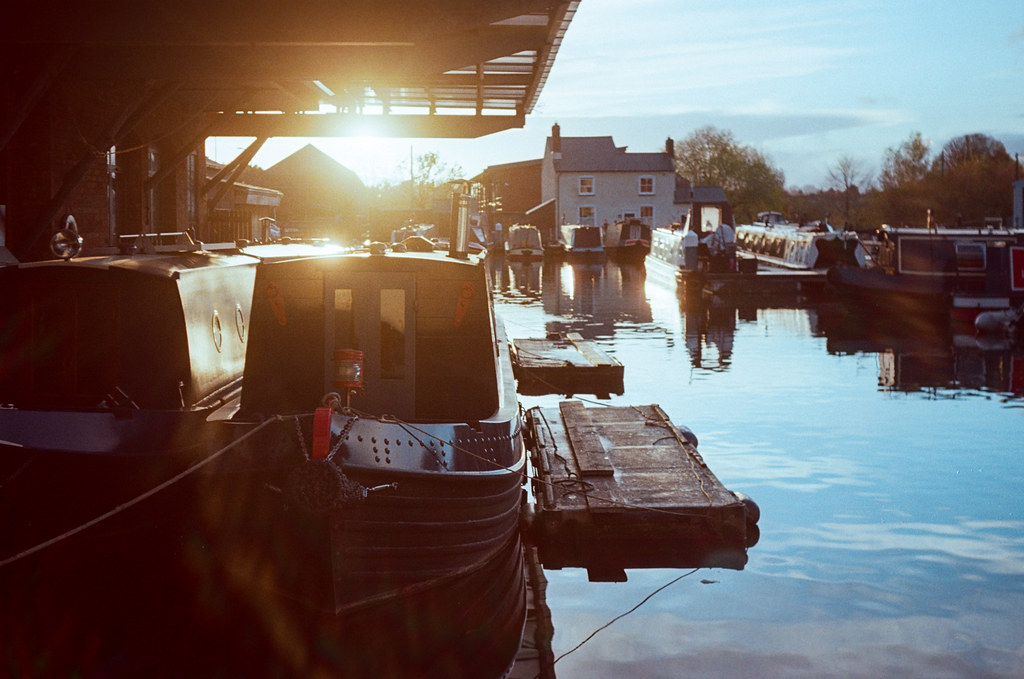
Of course there is some flare where I pointed it at the sun, there’s a little barrel distortion to be found too, but aside from that, I think the results are really quite impressive for a lens of its age – especially given how little the Voigtlander Vito II can be bought for. It’s easy to forget just how good these simple old lens formulas can be.
Final thoughts
Short of some recent experiences with a Leica 1, it’s been a while since I’ve shot a camera of this sort of age. The difference between shooting a Voigtlander Vito II and the Leica lies in the layout of the controls. The Leica – despite being a few years older – gives a user experience that’s not hugely different from a more modern camera. It’s quite easy to take a shutter dial located on the top of the camera for granted until you use a camera like the Voigtlander Vito II.
Even as someone with fairly considerable experience shooting all sorts of different cameras, I’ve stumbled over the need to manually cock the shutter, and gone temporarily cross eyed looking at the controls. For me though, this is part of the joy of shooting an old camera like this once in a while – I think it’s good to test yourself with something that makes you think just a little bit harder, especially when you know deep down you are handling something that’s fundamentally so very simple to use.
Of course, all this is going to sound quite amusing to those of you out there who regularly shoot folders and other more elderly cameras – after all, as I’ve said, there really is nothing complicated about the Voigtlander Vito II once you get used to it. It just involves a simple process of opening the camera, cocking the shutter, setting the speed, the aperture and required focused distance for either the subject or your zone of focus, and shooting. By this merit, the Voigtlander Vito II offers a purity of shooting that’s incredibly attractive to me – I really should shoot cameras of this sort of vintage more often…
Share this post:
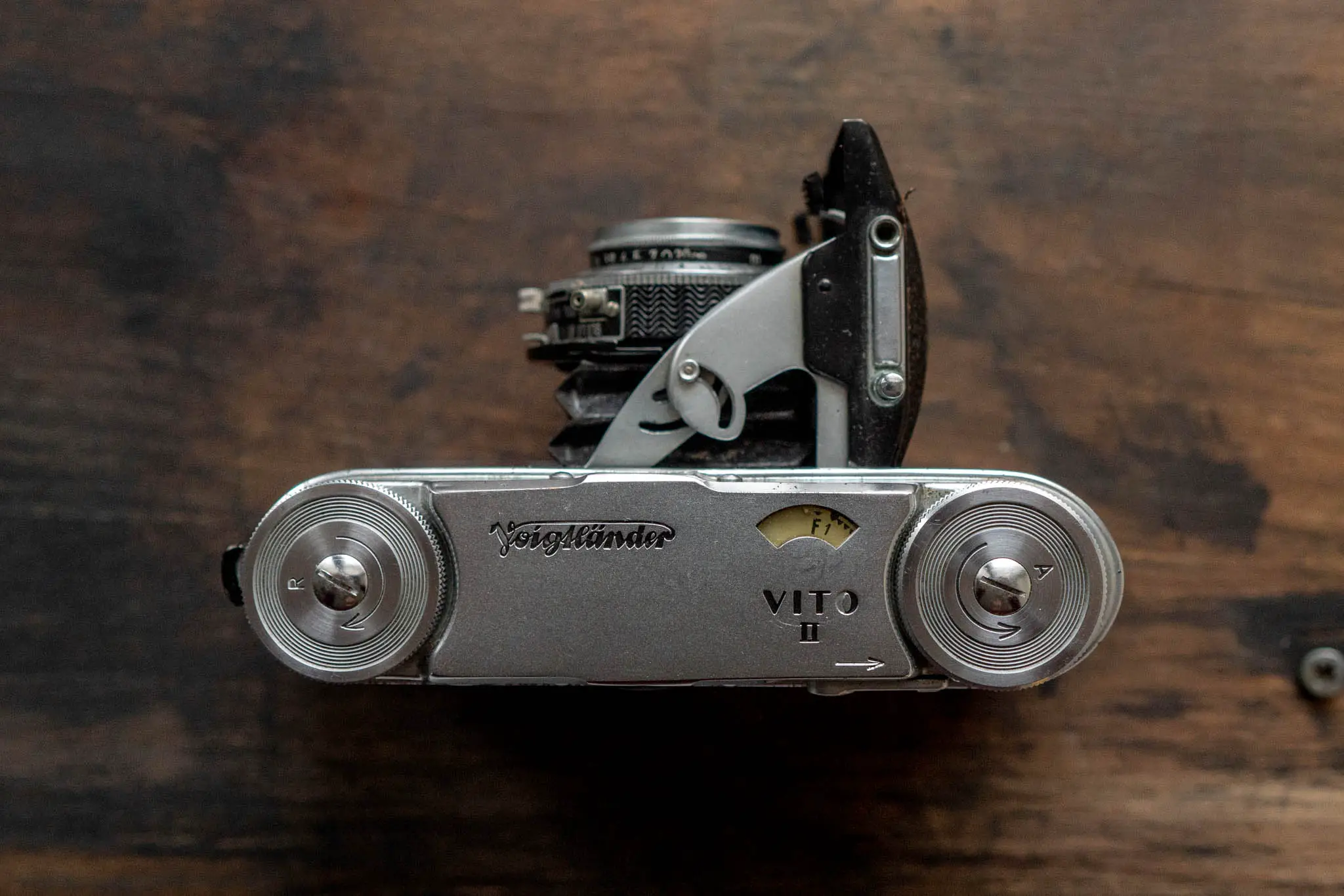








Comments
Flavio Colker on Voigtlander Vito II review – A simple folding 35mm compact camera
Comment posted: 23/11/2018
I am professional photographer and after decades of worrying about selling my work, only.. i am back to camera love where it all started. So i´ve been navigating rangefinder forums but avoiding silly attitudes as much as much as possible. I am glad i found this oasis of humble, well written love letters to cameras; that´s how i see your work and i applaud!
Comment posted: 23/11/2018
OldJim on Voigtlander Vito II review – A simple folding 35mm compact camera
Comment posted: 23/11/2018
The only issue that I stumbled on was getting the film loaded - turns out I needed to trim it to get into the takeup spool. Not obvious, but easy to fix once I figured it out.
Nick Lyle on Voigtlander Vito II review – A simple folding 35mm compact camera
Comment posted: 23/11/2018
Comment posted: 23/11/2018
paul snaith on Voigtlander Vito II review – A simple folding 35mm compact camera
Comment posted: 23/11/2018
Comment posted: 23/11/2018
janourda on Voigtlander Vito II review – A simple folding 35mm compact camera
Comment posted: 23/11/2018
Kevin Thomas on Voigtlander Vito II review – A simple folding 35mm compact camera
Comment posted: 23/11/2018
The Vito II is one of my favorite cameras. I got it in a group of 4 cameras from Goodwill, and fell in love with it. It pops right in a pocket, so I've usually got it when I go on a Photowalk. As you say, set it from a general exposure or sunny 16, zone focus and have fun (or use the 'how many times would I need to fall forward' rule ????????). Thanks to this camera I've not gotten a real urge to get a more modern compact. My one quibble is the latch for the back ???? It'll even do double exposure easily!
Comment posted: 23/11/2018
Comment posted: 23/11/2018
Bent_Brent on Voigtlander Vito II review – A simple folding 35mm compact camera
Comment posted: 24/11/2018
Comment posted: 24/11/2018
Andrew Cotterill on Voigtlander Vito II review – A simple folding 35mm compact camera
Comment posted: 24/11/2018
btw, I've a small collection of Vito Bs , mainly as a result of your original post about it years ago as I was getting into film. Recently got a friend to take his first steps into film with one of them. He did't want to give it back.
Comment posted: 24/11/2018
Daniel Castelli on Voigtlander Vito II review – A simple folding 35mm compact camera
Comment posted: 25/11/2018
That was/is me on both sides of the retail counter! Worked in both a camera store & an art store. Best education in the world to learn how to work/interact with people. In our digital age (not a bash; just a statement of fact) these places have all but disappeared. We have lost an irreplaceable source of ideas, an exchange of stories, both true and "fisherman tales" and just good places to hang out.
If you still have a place like this, keep going and buying! They are precious and must continue.
Sorry Hamish for the totally off tangent stream of thought! I believe you were saying something about a camera?
Comment posted: 25/11/2018
Joshua Fast on Voigtlander Vito II review – A simple folding 35mm compact camera
Comment posted: 26/11/2018
OldJim on Voigtlander Vito II review – A simple folding 35mm compact camera
Comment posted: 27/11/2018
The only issue I had was to load it - the leader did not fit. After a bit of looking closely, I took out my ABLON and cut an arrowshaped leader and lo. it worked! I found the "lever up, wind on, lever up" to get the film going a bit fiddly, but I guess it becomes part of muscle memory eventually.
It feels like it was designed in the true sense of the word - I am looking forward to using it.
John Murch on Voigtlander Vito II review – A simple folding 35mm compact camera
Comment posted: 08/01/2019
John Murch on Voigtlander Vito II review – A simple folding 35mm compact camera
Comment posted: 08/01/2019
Comment posted: 08/01/2019
Keith Walker on Voigtlander Vito II review – A simple folding 35mm compact camera
Comment posted: 18/04/2019
Comment posted: 18/04/2019
Andrew in Austin, Texaas on Voigtlander Vito II review – A simple folding 35mm compact camera
Comment posted: 25/06/2019
With regards to the Vito II, I have one from the year of my birth and for most of the read, I found myself nodding in agreement. As in the shared photos, static subjects and scenery are a no brainer. Scale focusing at f/8 or above is easy when outdoors on a sunny summer day. Try to shoot @ ISO 200. In deep shade, especially late in the day in the winter, good luck with subjects that are closer to the camera. I pull out an accessory rangefinder - especially when photographing people.
Photographing people in fluid setting can be a bit of challenge. It's best to have everything preset on the camera, to include the focus. Unless its a pose, pick the spot where you want your subject to be, if they are a random person on the street - then hope and wait for them to enter that location. It isn't an easy method, but from my experience no one wants to wait around while the photographer fiddles with their quaint camera. It's the same technique that I use with a Rollei 35.
Be aware of camera shake on a folder, the Vito has a fairly long through on the shutter release for a 35mm camera. A slow, gentle squeeze is best.
Comment posted: 25/06/2019
TD on Voigtlander Vito II review – A simple folding 35mm compact camera
Comment posted: 28/07/2019
Comment posted: 28/07/2019
David Hume on Voigtlander Vito II review – A simple folding 35mm compact camera
Comment posted: 10/08/2019
I guess shutter cocking on the lens and no interlock - really nothing to prevent continuous winding on is what I need. I'd ideally like a 24 x 24 mask, but I could hack one of those as long as the winding on is continuous. Is there anything out there?
All the best
David
Comment posted: 10/08/2019
David Hume on Voigtlander Vito II review – A simple folding 35mm compact camera
Comment posted: 12/08/2019
PJ T on Voigtlander Vito II review – A simple folding 35mm compact camera
Comment posted: 21/01/2020
Do you have any experience with its progeny, the Vito III? found one in an antiques store around 1988 and have been in love with it ever since.
Cheers from New England!
Pete T
Comment posted: 21/01/2020
Kristine on Voigtlander Vito II review – A simple folding 35mm compact camera
Comment posted: 16/06/2020
Comment posted: 16/06/2020
Cat on Voigtlander Vito II review – A simple folding 35mm compact camera
Comment posted: 24/07/2020